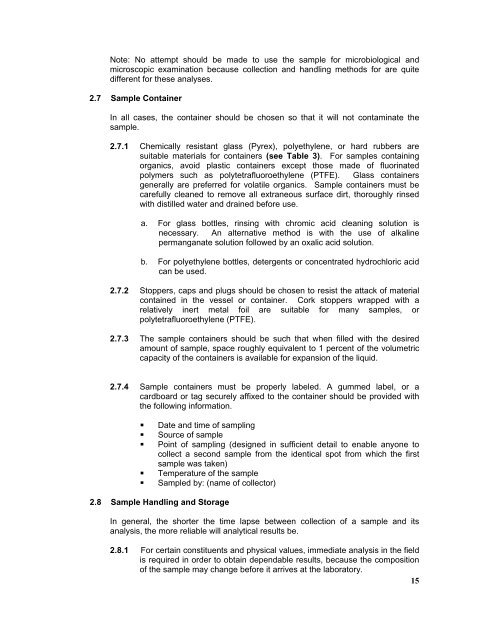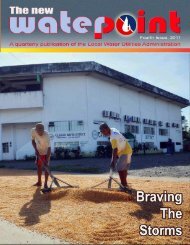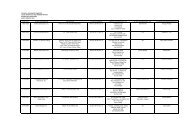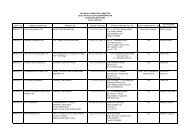Philippine National Standards for Drinking Water - LWUA
Philippine National Standards for Drinking Water - LWUA
Philippine National Standards for Drinking Water - LWUA
You also want an ePaper? Increase the reach of your titles
YUMPU automatically turns print PDFs into web optimized ePapers that Google loves.
Note: No attempt should be made to use the sample <strong>for</strong> microbiological and<br />
microscopic examination because collection and handling methods <strong>for</strong> are quite<br />
different <strong>for</strong> these analyses.<br />
2.7 Sample Container<br />
In all cases, the container should be chosen so that it will not contaminate the<br />
sample.<br />
2.7.1 Chemically resistant glass (Pyrex), polyethylene, or hard rubbers are<br />
suitable materials <strong>for</strong> containers (see Table 3). For samples containing<br />
organics, avoid plastic containers except those made of fluorinated<br />
polymers such as polytetrafluoroethylene (PTFE). Glass containers<br />
generally are preferred <strong>for</strong> volatile organics. Sample containers must be<br />
carefully cleaned to remove all extraneous surface dirt, thoroughly rinsed<br />
with distilled water and drained be<strong>for</strong>e use.<br />
a. For glass bottles, rinsing with chromic acid cleaning solution is<br />
necessary. An alternative method is with the use of alkaline<br />
permanganate solution followed by an oxalic acid solution.<br />
b. For polyethylene bottles, detergents or concentrated hydrochloric acid<br />
can be used.<br />
2.7.2 Stoppers, caps and plugs should be chosen to resist the attack of material<br />
contained in the vessel or container. Cork stoppers wrapped with a<br />
relatively inert metal foil are suitable <strong>for</strong> many samples, or<br />
polytetrafluoroethylene (PTFE).<br />
2.7.3 The sample containers should be such that when filled with the desired<br />
amount of sample, space roughly equivalent to 1 percent of the volumetric<br />
capacity of the containers is available <strong>for</strong> expansion of the liquid.<br />
2.7.4 Sample containers must be properly labeled. A gummed label, or a<br />
cardboard or tag securely affixed to the container should be provided with<br />
the following in<strong>for</strong>mation.<br />
• Date and time of sampling<br />
• Source of sample<br />
• Point of sampling (designed in sufficient detail to enable anyone to<br />
collect a second sample from the identical spot from which the first<br />
sample was taken)<br />
• Temperature of the sample<br />
• Sampled by: (name of collector)<br />
2.8 Sample Handling and Storage<br />
In general, the shorter the time lapse between collection of a sample and its<br />
analysis, the more reliable will analytical results be.<br />
2.8.1 For certain constituents and physical values, immediate analysis in the field<br />
is required in order to obtain dependable results, because the composition<br />
of the sample may change be<strong>for</strong>e it arrives at the laboratory.<br />
15







